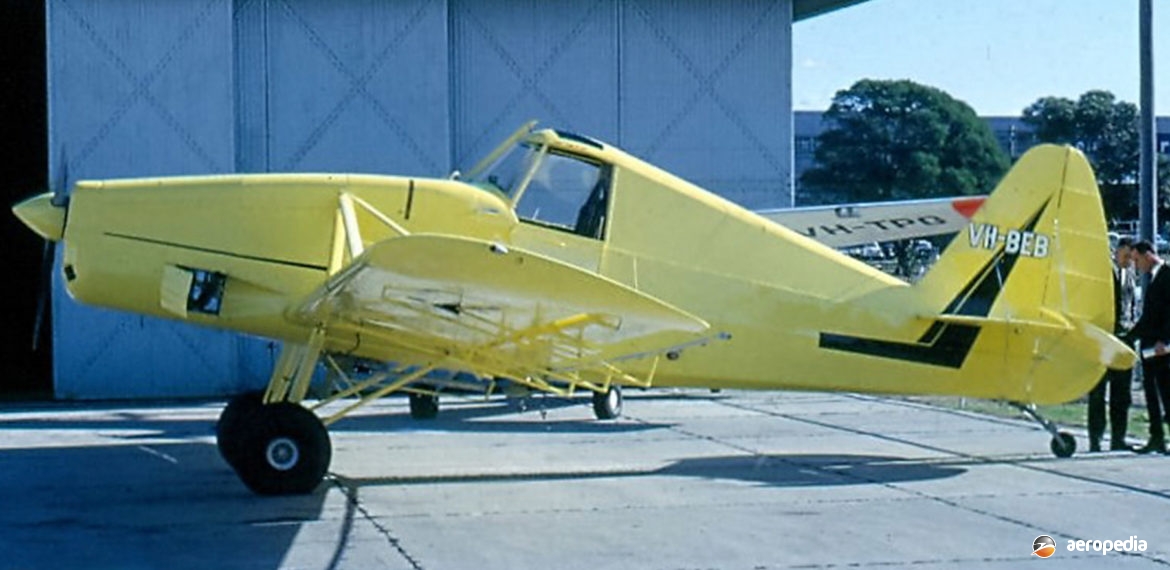Photograph:
Call Air B-1 VH-BEB (c/n 10-008) at Bankstown, NSW in November 1966 (David C Eyre)
Country of origin:
United States of America
Description:
Single-seat agricultural monoplane
Power Plant:
One 298 kw (400 hp) Lycoming IO-720-A1A eight-cylinder horizontally-opposed air-cooled engine
Specifications:
- Wingspan: 13.44 m (44 ft)
- Length: 9.1 m (30 ft)
- Height: 3.04 m (10 ft)
- Max speed: 191 km/h (119 mph)
- Cruising speed at 75% power: 177 km/h (115 mph)
- Range: 644 km (400 miles)
- Empty weight: 1,134 kg (2,500 lb)
- Loaded weight: 2,245 kg (4,750 lb)
History:
The Call Air Model B-1 agricultural aircraft was a development of the smaller A-9 series and was of similar configuration, being designed and manufactured by the Inter Mountain Manufacturing Company of Wyoming, USA (IMCO).
The prototype (N7200V) made its first flight at Afton, Wyoming on 15 January 1966. Almost twice the size of the A-9, the B-1 had a hopper capacity of 1,135 litres (300 US gals / 250 Imp gals) or 1,132 m³ (40 cub ft). A total of 36 examples was built, 35 at the company’s facility at Afton, and it appears one more when the Company was taken over by Rockwell, which then changed the name of the type to Snipe Commander.
The first production machine (N7201V) flew in March 1966 and at that time orders had been received for 21 aircraft. First export aircraft were to New Zealand in June 1966, these aircraft being imported by Aero Engine Services Ltd of Hamilton. The first was registered to Airwork (NZ) Ltd of Christchurch, becoming ZK-CRC (c/n 10006), being followed by ZK-CRD (c/n 10017) in July 1966. Six furthe,r aircraft were imported in 1966. Main users of the type were Rangitikei Air Services, Air Services and Air Contracts on the north island and Auster Air Services on the south island. A few survivors ended up with Airwork, this company taking over Auster Air Services and Otago Air Services.
It would seem all the New Zealand examples had the previous identity N26B, and it would seem this registration was used for flight testing in the United States. The first aircraft was registered in July 1966 and the last in September that year.
The Call Air B-1 aircraft registered in New Zealand have included: ZK-CRA (c/n 1011 – ex N26B) which crashed at Orari Gorge in September 1977; ZK-CRB (c/n 10012 – ex N26B) which was withdrawn from service at Rangiora in August 1978 and scrapped; ZK-CRC (c/n 10006 – ex N26B) which was withdrawn from service at Rangiora in August 1978 and scrapped; ZK-CRD (c/n 10017 – ex N26B) which crashed at Hunterville in February 1969; ZK-CRI (c/n 10018 – ex N26B) which was withdrawn from use at Timaru in May 1975 and scrapped; ZK-CRJ (c/n 10020 – ex N26B) which crashed at Dunback in September 1975; ZK-CRT ntu (c/n 10023) which was not imported and became N7280V in the United States in 1966; and ZK-CRV (c/n 10030 – ex N26B) which crashed at Oamaru in June 1973 and was subsequently scrapped.
Other exports went to the French Colonies (F-OGCS), two to Canada (CF-UZA and CF-WVT) and one to Sweden (SE-EWA).
Two were imported to Australia by the local agent, Aerial Agriculture of Bankstown, NSW, and these aircraft arrived in October 1966, becoming VH-BEB (c/n 10008) and VH-BEC (c/n 10014 – ex N59015). They were not popular and were returned to the United States the following year, being struck off the register in November 1967, VH-BEC becoming N9488, later going to Turkey in May 1968 as TC-NAF.
The performance of the Call Air B-1 did not match its size and some effort was put into increasing the performance, including the installation of the Pratt & Whitney R-985 radial engine. One such installation was ZK-CRU in 1967, being flown for the first time on 20 November that year, but this machine was destroyed in an accident at Wangaehu in the following year on 16 March.
The last flight in New Zealand by a Call Air B-1 was ZK-CRC on 7 August 1978, the remains of this aircraft being held in storage at Ferrymead near Christchurch for restoration for static display.

